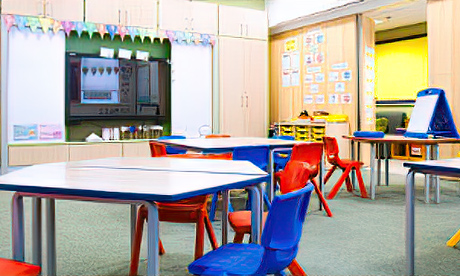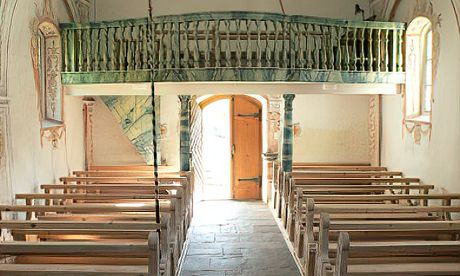Philosophers often point out that space is one of the basic prerequisites of human experience.
We exist as spatial creatures – we have size and location and movement. We imagine ourselves ‘in space,’ we arrange things in space in relation to other items located around us. We constantly locate (i.e. put in a place in space) people, things and ideas.
We do not experience without invoking our sense of ‘space’ – even in matters of faith we imagine ‘heaven’ as a place ‘in the heavens.’
We may know that it is not as simple as that – and giggle when we hear that Yuri Gagarin said that there is no god because he had been in space and could not see him – but we cannot imagine without some sort of location. So, we pray to our Father who is in heaven.
But we rarely reflect on this aspect of our humanity.
And this is especially true of us as Christians who celebrate a liturgy: we use space and place to express our relationship to God, God’s relationship with us, and our relationships with one another as sisters and brothers in baptism.
Put another way, if we are people who engage in liturgy, then we have to start thinking seriously about space, the shape of the environment in which we worship, and how that space can either facilitate or hamper our sharing.
After Vatican II we intended to think about the space in which we worship – and how it might manifest an ecclesiology – but for the most part, we ducked the issue.
Instead of changing the space in which we, the whole People of God, worship, we often just moved the furniture that was immediately around the presiding presbyter.
Often this was so little considered that even the people responsible thought it was just a matter of visibility: as if the presider was doing something on a stage and the congregation were there as observers.
The challenge that Sacrosanctum Concilium had set was to find a spatial arrangement that helps all to experience themselves as a celebrating community, united in the Christ, thanking the Father.
Now, quite suddenly, we are thinking of space.
Churches are partially re-opened in most places and we have to be arranged differently.
In order to keep socially distanced, we have become spatially conscious.
Therefore, this is a good time to think about the spaces of our worship and what they might tell us and what they might be.
Two classrooms
If we are going to think about the importance of space to us as communities, it is a good idea to start with a simple case.
We all have some experience with classrooms, all of us have spent some years of our lives going into them.
The classroom is a physical shape / space that has shaped each of us and possible has mis-shaped us in our attitudes to learning and education.
Look at this image – it is virtually identical to the classroom in which I spent all my school years – and what does it say to you?

This is a room where life is very organised.
It is a room that exudes authority in its arrangement. It is not designed to encourage doubt, discussion, or individuality. Discipline is at a premium.
In turn, it is related to a philosophy of education.
The student is a vacant empty vessel that is filled by the teacher pouring in the necessary facts.
There is a cleaned blackboard behind the teacher, literally a tabula rasa, and this is matched by the minds of the students in the desks: each mind is a tabula rasa – and the teacher by putting facts on the blackboard is imagined to be impressing the same facts on to the minds ranged in desks in front.
Education is viewed as essentially the downloading of information from a giver (the teacher who is a figure of authority different in status from pupils) to a group of receivers.
The spatial set up exists in a binary world: givers – receivers; possessor – non-possessors; speakers – listeners; superiors – inferiors.
There is little room for overlaps: you either know or don’t know.
It is an image not unlike that of the Church promoted by Pope St Pius X: the Church is made up of two unequal parts: clergy who teach and command and are its ‘active’ part (the ecclesia docens) and the laity who are led, listen and obey, and whose role is passive and receptive (the ecclesia discens).
Now look at a modern classroom and what response does it evoke?

This set up supposes that education is a far more complex process than what could be described with the simile of an empty vessel being filled by having facts poured into it.
The new arrangement of classrooms came about because teachers and educational psychologists realised that the older arrangement performed so badly.
This comes as a surprise to many conservatives who dream of a halcyon time of ‘serious schooling’ and teachers who dished out ‘reading, writing and [a]rithmatic’ along with a Q&A catechism!
But if it worked so well, then why are languages – where you have to learn to be creative – so rarely mastered through that process?
We have learned, slowly but surely, that moving the classroom furniture around, having many displays and changing them, and having fresh seating arrangements either for the whole group or small groups facilitates learning, sharing, discovering and growing not only in understanding but in the significance of what is being learned.
Classroom spatial layout can impact on attention spans during a lesson, creativity, motivation, the students’ wellbeing, and how much they take away (note another spatial image) with them.
In short, it is designed to foster collaboration between everyone there, pupils and teacher, and the teacher is less an oracle than an experienced guide.
Underlying beliefs of second classroom
Now let’s reflect on the underlying philosophy of knowledge that is at work in the second set up.
It assumes that each person in the room brings something to both learning and to the group.
Moreover, learning is personal: each individual learns differently and who they sit near may make a difference.
The common tables show that we learn within communities and that we must share knowledge. I may only have ‘two cents worth’ – but I can share it with the group.
Put another way, we are not blank pages but know stuff and have intelligence.
We do not record information for repetition but process it for use in our lives.
This takes place in groups – and it is within small groups that we do our most important growing.
And, most importantly, knowledge itself is not a fixed body of facts but something evolving, unfolding, and the result of the discovery.
Now a liturgical space
Look at this familiar scene: a church looking down from the sanctuary towards the door.

It is a small country church and it could be anywhere in the Catholic world any time in the last few centuries.
The benches arrived after the Reformation, and were put there to encourage people to sit still and listen to sermons.
Unlike in Protestant churches there was no emphasis on listening to readings at Mass. These were in Latin, and since there was an assumption that no one would actually listen, they were usually read by the priest – facing away from the people he was presumably reading them to – in a low voice that could not have been heard beyond the altar rails in even a small building like this.
This attitude to the readings did begin to change in the early-twentieth-century with some priests encouraging ‘people’s missals.’
In these books, someone could read the readings in the local language – but few bothered; such missals were treated as books of prayers by the minority who could afford them.
The notion that the assembly might listen to the readings – read by one priest from the pulpit in the local language while the presider read them in Latin – is an idea from the late 1950s.
Actually listening to readings only began in the late 1960s, and the current practice began in 1970.
Looking at this building, the simple question that arises is this: is it more like the old classroom or the modern one?
Few would doubt that this is a space very much like the classroom with the ranked desks.
Indeed, the lecture hall and the nave were spaces that were often compared. In both cases the seating was to promote stillness in the listeners, while the active part of transmitting took place in front.
Do not simply resume, Renew!
Now that we have to be specially arranged in the pews to allow social distancing, we have become aware of the actual space in a new way.
Indeed, we can ask ourselves if this space – in many ways analogous to the arrangement in a cinema or theatre – is appropriate for what we are doing when we sit / stand there.
For the sake of space, we can only look at the appropriateness of the arrangement for the first part of our Sunday gathering: the Liturgy of the Word.
At the moment we are spaced out, usually in benches / pews / firmly fixed seating; but is there a better way?
Let’s start with the readings.
We are supposed to listen to the first reading (taken from the Old Testament) and the gospel each Sunday as part of a story that reveals to us our deepest identity as disciples.
The inheritance that is the Old Testament is the bedrock which made the first followers listen to Jesus.
We have a bad history of treating it as ‘just background’ or ‘what’s out of date.’ But we need to keep reminding ourselves of it – this is why we read it each Sunday – because without absorbing it to some extent, we cannot appreciate what is being proclaimed in the gospel.
So we need an arrangement that facilitates attention to what the reader is drawing to our minds.
The normal way that such listening is facilitated is well-spaced chairs so that each can see the reader directly.
Just imagine someone coming into an office and reading out the latest financial figures and watch how people arrange themselves to hear it: this is the model for listening to the first reading (and for that matter, the reading from one of the early church authors such as Paul).
But we are not only listeners but responders: the psalm is a hymn of praise.
So we should have an arrangement that allows for a group singing or for a special group of singers.
Likewise, many of the psalms assume movement.
Indeed, until the arrival of fixed seats, this was often a time of processions and movement and dance – that is why so many of the ‘sequences’ – which do not work when simply read – have a drum-beat rhythm.
The gospel is heard not simply as information – which can be true of both the Old Testament reading and the Epistle – but as a moment when disciples hang on the words of the Master.
Our standing together is an act of communal solidarity: we are the ones who are standing together as the disciples.
This can never be conveyed when standing in ranks one arranged behind another.
There is a curious demonstration of this spatial arrangement in military affairs. When the formal instructions are over, the general for the pep talk seeks to get the soldiers ‘to gather around’ and there sense their togetherness with one another, with him, and with the cause.
This sense of standing together, shoulder to shoulder, then takes on a new meaning when we come to the Prayer of the Faithful.
This is not just our individual ‘letters to Santa’ for what we want, but the baptised people acting as a priestly people making intercession, with the Christ, for the assembly, the whole Church of God, and all humanity.
Here we are to imagine ourselves – using imagery that goes back to the temple in Jerusalem and which has come to us through the Letter to the Hebrews – as standing in the courtyard of heaven, with the dignity to stand in God’s presence and make intercession.
It is a corporate act, and out arrangement should show this.
So also in the Profession of Faith, another corporate act: we assert who we are and – note once more the spatial image – ‘where we stand.’ We are the group who believe in God, – Father, Son, and Spirit – and look forward to the resurrection of the dead and the life of the world to come.
We stand together in this profession!
That leaves the homily.
Imagine that you want to give a message that is friendly, helpful and encouraging to a group of people whom you see as your family – and address as sisters and brothers.
What sort of arrangement would you choose?
The odds are that you would do anything but adopt the spatial arrangements we use normally on a Sunday!
Our standard space smacks of ‘speaking down’ to people, ‘giving out’ to inferiors, inequality, a model of ‘I know but you do not’ education, and it encourages the style of lecture hall rhetoric.
The word ‘preaching’ is a word with negative undertones.
It is at this point it is easiest to see why a sociological survey of Christian worship found that people were turned off by its being ‘pompous, patronising, and paternalistic.’
Covid-19 or not, we have a major problem with the spatial arrangements of our preaching.
We no longer refer to this moment as a ‘sermon’ but as a ‘homily.’
What a curious word: why not call it a speech (it is often as boring and as long-winded) or a lecture (it often has that didactic tone that brings to mind the song: “Papa, don’t preach”)?
Homily – the word comes from Greek – implies a dialogue, a conversation, a sharing of insights.
The situation also requires respect from the one giving the homily: the Spirit is at work in every heart and many of who are listening have more to give the conversation than the homilist.
No spatial arrangement is more in need of renewal.
- Thomas O’Loughlin is a priest of the Catholic Diocese of Arundel and Brighton, emeritus professor of historical theology at the University of Nottingham (UK) and director of the Centre of Applied Theology, UK. His latest award-winning book is Eating Together, Becoming One: Taking Up Pope Francis’s Call to Theologians (Liturgical Press, 2019).
News category: Analysis and Comment.




